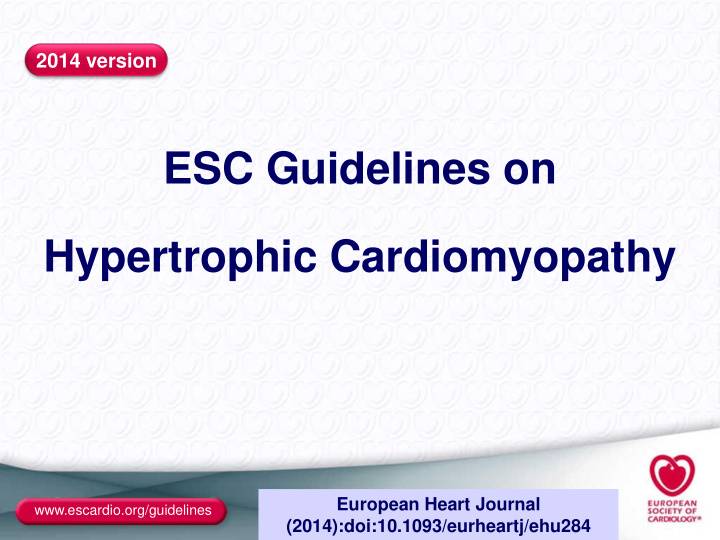



2014 version ESC Guidelines on Hypertrophic Cardiomyopathy European Heart Journal www.escardio.org/guidelines European Heart Journal (2014):doi:10.1093/eurheartj/ehu284 (2014):doi:10.1093/eurheartj/ehu284
2014 ESC Guidelines on diagnosis and management of hypertrophic cardiomyopathy Authors/Task Force members: Perry M. Elliott (Chairperson) (UK), Aris Anastasakis (Greece), Michael A. Borger (Germany), Martin Borggrefe (Germany), Franco Cecchi (Italy), Philippe Charron (France), Albert Alain Hagege (France), Antoine Lafont (France), Giuseppe Limongelli (Italy), Heiko Mahrholdt (Germany), William J. McKenna (UK), Jens Mogensen (Denmark), Petros Nihoyannopoulos (UK), Stefano Nistri (Italy), Petronella G. Pieper (Netherlands), Burkert Pieske (Austria), Claudio Rapezzi (Italy), Frans H. Rutten (Netherlands), Christoph Tillmanns (Germany), and Hugh Watkins (UK). Additional Contributor: Constantinos O'Mahony (UK). www.escardio.org/guidelines European Heart Journal (2014):doi:10.1093/eurheartj/ehu284
Acknowledgements ESC Committee for Practice Guidelines (CPG): Jose Luis Zamorano (Chairperson) (Spain), Stephan Achenbach (Germany), Helmut Baumgartner (Germany), Jeroen Bax (Netherlands), Héctor Bueno (Spain), Veronica Dean (France), Christi Deaton (UK), Çetin Erol (Turkey), Robert Fagard (Belgium), Roberto Ferrari (Italy), David Hasdai (Israel), Arno W. Hoes (Netherlands), Paulus Kirchhof (Germany/UK), Juhani Knuuti (Finland), Philippe Kolh (Belgium), Patrizio Lancellotti (Belgium), Ales Linhart (Czech Republic), Petros Nihoyannopoulos (UK), Massimo F. Piepoli (Italy), Piotr Ponikowski (Poland), Per Anton Sirnes (Norway), Juan Luis Tamargo (Spain), Michal Tendera (Poland), Adam Torbicki (Poland), William Wijns (Belgium), and Stephan Windecker (Switzerland). Document Reviewers: David Hasdai (Israel) (CPG Review Coordinator), Piotr Ponikowski (Poland) (CPG Review Coordinator), Stephan Achenbach (Germany), Fernando Alfonso (Spain), Cristina Basso (Italy), Nuno Miguel Cardim (Portugal), Juan Ramón Gimeno (Spain), Stephane Heymans (Netherlands), Per Johan Holm (Sweden), Andre Keren (Israel), Paulus Kirchhof (Germany/UK), Philippe Kolh (Belgium), Christos Lionis (Crete), Claudio Muneretto (Italy), Silvia Priori (Italy), Maria Jesus Salvador (Spain), Christian Wolpert (Germany), and Jose Luis Zamorano (Spain). National Cardiac Societies document reviewers www.escardio.org/guidelines European Heart Journal (2014):doi:10.1093/eurheartj/ehu284
Cardiomyopathy: Definition ● “ A myocardial disorder in which the heart muscle is structurally and functionally abnormal, in the absence of coronary artery disease, hypertension, valvular disease and congenital heart disease sufficient to cause the observed myocardial abnormality. ” ESC Working Group on Myocardial Pericardial Diseases (Elliott P et al. EHJ 2007) www.escardio.org/guidelines European Heart Journal (2014):doi:10.1093/eurheartj/ehu284
Hypertrophic Cardiomyopathy www.escardio.org/guidelines European Heart Journal (2014):doi:10.1093/eurheartj/ehu284
HCM: Definitions Increased left ventricular wall thickness not solely explained by abnormal loading conditions ADULTS: ● LV wall thickness ≥15 mm in one or more LV myocardial segments measured by any imaging technique CHILDREN: ● LV wall thickness more than two standard deviations above the predicted mean (z-score >2) www.escardio.org/guidelines European Heart Journal (2014):doi:10.1093/eurheartj/ehu284
Cardiomyopathies HCM DCM ARVC RCM Unclassified Familial/Genetic Non-familial/Non-genetic Unidentified Disease sub-type* Idiopathic Disease sub-type* gene defect European WG on Myocardial and Pericardial Diseases (Elliott P et al. EHJ 2007) www.escardio.org/guidelines European Heart Journal (2014):doi:10.1093/eurheartj/ehu284
The majority of cases in adolescents and adults are caused by mutations in sarcomere protein genes. www.escardio.org/guidelines European Heart Journal (2014):doi:10.1093/eurheartj/ehu284
General approach to the diagnosis of hypertrophic cardiomyopathy www.escardio.org/guidelines European Heart Journal (2014):doi:10.1093/eurheartj/ehu284
History and Physical Examination • How old is the patient? • Family history? • Non-cardiac symptoms & signs? www.escardio.org/guidelines European Heart Journal (2014):doi:10.1093/eurheartj/ehu284
History & physical examination • How old is the patient? • Family history? • Non-cardiac symptoms & signs www.escardio.org/guidelines European Heart Journal (2014):doi:10.1093/eurheartj/ehu284
Electrocardiogram ● Value of ECG – Distribution of hypertrophy – Myocardial fibrosis – Early diagnosis in relatives – Diagnostic red flags www.escardio.org/guidelines European Heart Journal (2014):doi:10.1093/eurheartj/ehu284
Electrocardiographic abnormalities suggesting specific diagnoses or morphological variants www.escardio.org/guidelines European Heart Journal (2014):doi:10.1093/eurheartj/ehu284
ECHOCARDIOGRAPHY www.escardio.org/guidelines European Heart Journal (2014):doi:10.1093/eurheartj/ehu284
Echocardiography ● All LV segments from base to apex should be examined, ensuring that the wall thickness at mitral, mid-LV and apex is recorded. www.escardio.org/guidelines European Heart Journal (2014):doi:10.1093/eurheartj/ehu284
Echocardiography: Differential Diagnosis Interpret images in context of clinical features and other tests www.escardio.org/guidelines European Heart Journal (2014):doi:10.1093/eurheartj/ehu284
CARDIAC MRI www.escardio.org/guidelines European Heart Journal (2014):doi:10.1093/eurheartj/ehu284
Cardiac Magnetic Resonance Imaging CMR should be considered in patients with HCM at their baseline assessment if local resources and expertise permit. Value of Cardiac CMR: ● LV morphology and function ● Myocardial fibrosis ● Differential Diagnosis www.escardio.org/guidelines European Heart Journal (2014):doi:10.1093/eurheartj/ehu284
Circulation 2005;111:186-93 www.escardio.org/guidelines European Heart Journal (2014):doi:10.1093/eurheartj/ehu284
LABORATORY TESTS www.escardio.org/guidelines European Heart Journal (2014):doi:10.1093/eurheartj/ehu284
Value of laboratory testing • Assessment of extra-cardiac disease/complications • (e.g. renal function) • Severity of LV dysfunction • (e.g. natriuretic peptides) • Diagnostic Red Flags • (e.g. creatine kinase) • Confirmatory tests in phenocopies www.escardio.org/guidelines European Heart Journal (2014):doi:10.1093/eurheartj/ehu284
Recommended Laboratory Tests www.escardio.org/guidelines European Heart Journal (2014):doi:10.1093/eurheartj/ehu284
Recommended Laboratory Tests www.escardio.org/guidelines European Heart Journal (2014):doi:10.1093/eurheartj/ehu284
GENETIC COUNSELLING & TESTING www.escardio.org/guidelines European Heart Journal (2014):doi:10.1093/eurheartj/ehu284
Genetic Counselling Genetic counselling is recommended in all patients when HCM cannot be explained solely by a non-genetic cause ● Understand psychological, social, professional, ethical & legal implications of a genetic diagnosis. ● Gather information on other family members that helps to determine probability of genetic disease and possible aetiology. www.escardio.org/guidelines European Heart Journal (2014):doi:10.1093/eurheartj/ehu284
Genetic Testing www.escardio.org/guidelines European Heart Journal (2014):doi:10.1093/eurheartj/ehu284
Genetic Testing ● Genetic testing is recommended in patients fulfilling diagnostic criteria for HCM to enable cascade genetic screening of their relatives ● When a definite causative genetic mutation is identified in a patient, his or her relatives should first be genetically tested, and then clinically evaluated if they are found to carry the same mutation www.escardio.org/guidelines European Heart Journal (2014):doi:10.1093/eurheartj/ehu284
Flow chart for genetic and clinical screening of probands and relatives. www.escardio.org/guidelines European Heart Journal (2014):doi:10.1093/eurheartj/ehu284
ASSESSMENT OF SYMPTOMS www.escardio.org/guidelines European Heart Journal (2014):doi:10.1093/eurheartj/ehu284
Chest pain Dyspnoea Syncope Fatigue Palpitations LVOT Obstruction LVOT Obstruction Arrhythmia Arrhythmia Abnormal Vascular LV Diastolic failure Function LV Systolic failure Valve Disease Microvascular dysfunction www.escardio.org/guidelines European Heart Journal (2014):doi:10.1093/eurheartj/ehu284
Investigation of Heart Failure Symptoms History & Physical When facilities are available, cardiopulmonary exercise testing… should be considered ECG & Echo at the initial clinical (exercise stress) evaluation Lab tests Assessment of LVOTO should be part of the routine evaluation of all symptomatic CPET patients. www.escardio.org/guidelines European Heart Journal (2014):doi:10.1093/eurheartj/ehu284
LV Outflow Tract Obstruction Elliott & McKenna: Textbook of Cardiology (Topol ed.) www.escardio.org/guidelines European Heart Journal (2014):doi:10.1093/eurheartj/ehu284
www.escardio.org/guidelines European Heart Journal (2014):doi:10.1093/eurheartj/ehu284
Recommend
More recommend